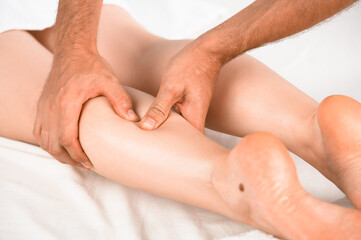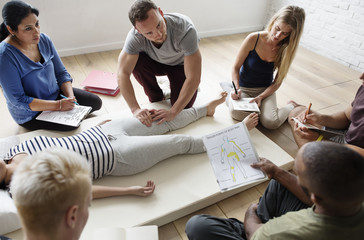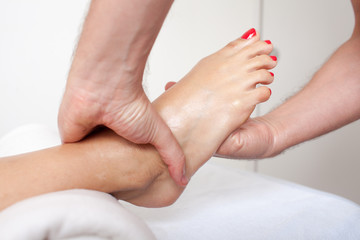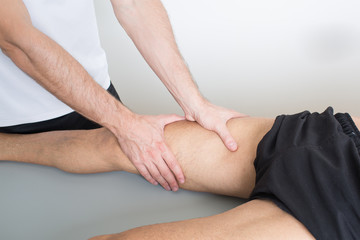
Rolfing, or structural integration, was created by Dr. Ida Rolf in the mid-1900s. It is a form of bodywork that understands that different parts of the entire body are connected. If one part is out of line, it can affect other areas. Rolfing focuses on the fascia, which is the connective tissue that wraps around muscles and organs. The goal is to restore balance, reduce chronic pain, and improve overall health. To watch an interview with a rolfing practitioner, click here.
The Concept and Philosophy Behind Rolfing
Ida Rolf created the idea of structural integration in the early 1900’s. She thought of the human body as a system made of connected parts building the fascial network. Fascia is a type of connective tissue that acts like a web, supporting our muscles, bones, and organs. Think of fascia as a bodysuit that connects every part of you from head to toe. She saw this network as very important for keeping the body healthy and functioning well. This is explained more in this interview.
When fascia is healthy, it is soft and lets you move easily but, unfortunately, injuries, repetitive actions, and emotional stress can make the fascia tight and misaligned. This, in turn, can lead to chronic pain, restrict how you move, and change the way you move.
Rolfing is based on the idea that when the body is aligned, it can move better, save energy, and feel less pain by releasing the tightness in the fascia. It tries to bring the body back to its balanced state, get back to its natural shape, improve posture, and move more easily.

Rolfing in Practice: Techniques and Modalities
A session is a special experience. It mixes manual therapy and moving your body. Practitioners use their hands to massage the fascia or perform myofascial release. They look for tight spots and places that feel stuck. This hands-on work helps to loosen these areas.
It does more than just work on the body’s physical side. Practitioners also help clients do specific movements and exercises. These exercises can increase body awareness and improve coordination. They help reeducate movement patterns that can cause posture issues.
The Ten-Session Series Explained
The main part of Rolfing is called the Ten-Session Series. This method focuses on different parts of the body, one session at a time, to create a balanced structure. Each session builds on the last, but it’s not just about fixing problems. It aims to bring back harmony and efficiency to the body.
Here’s a quick look at what the Ten-Session Series covers:
- Sessions 1-3: These sessions focus on the outer layers of fascia. They help with breathing patterns and build a balanced base from the feet to the rib cage.
- Sessions 4-7: These sessions go deeper into the body’s core. They work on the legs, pelvis, abdomen, and back while also freeing up tight areas in the neck and head.
- Sessions 8-10: In these sessions, the goal is to put everything together. This promotes smooth movement, better coordination, and a stronger connection to the body.
The Ten-Session Series is a common starting point, but it is not the same for everyone. Each session is tailored to meet the specific needs, structure, and goals of each person. The ‘Tens Series’ is explained more here.
Once clients complete the Ten-Session Series, they can look into advanced techniques. These special sessions focus on specific issues. They help with long-term tension caused by chronic stress, improve sports performance, and assist the body during changes or when healing from injuries.

Rolfing’s Place in Western and Alternative Medicine
Rolfing has a unique place in healthcare and the health benefits are becoming more recognized as a helpful addition to traditional care. Many doctors, physical therapists, and other health experts now send patients to Rolfers for problems like musculoskeletal imbalances, chronic pain, and limited movement.
Alternatively, it takes a holistic approach and connects with ideas found in different alternative medicine practices. It understands that the mind, body, and spirit are linked. It highlights how the body can heal itself when given the right support and conditions. This makes it a good addition to treatments like acupuncture, yoga, massage therapy, and the Alexander Technique.
Comparison with Conventional Therapies
Instead of just managing symptoms, it looks for the main causes of pain and problems and aims to fix the body’s structure. While pain relief from medicines is often short-lived, this aims to create lasting improvements. It focuses on better body alignment, improving movements, and re-training how the body works.
Physical therapy is important after injuries and surgeries. This may enhance physical therapy results by increasing the range of motion, lessening muscle tension, and encouraging better movement, leasing to an easier recovery.
It also stands out because it focuses on fascia. Whereas regular treatments usually look at muscles and bones, Rolfing understands that tightness in fascia can cause chronic pain, limited flexibility, and posture problems.

Training and Certification for Rolfers
Becoming a certified Rolfer™ is not easy. It requires a strong understanding of anatomy, physiology, biomechanics, and structural integration. Most people start a multi-year study at a school like the Rolf Institute for training and certification.
A bachelor’s degree is not always required, but many popular training schools like the Rolf Institute prefer it. Students with a background in healthcare, movement, or bodywork might find their past experience helpful. Work in fields like physical therapy, massage therapy, dance, or yoga can help them understand the body and how it moves.
The path to certification includes finishing a complete study program, which can take several years. Students will learn in classrooms, practice actively, and work under supervision to gain the skills they need to be good practitioners.
Many Rolfers decide to gain more knowledge by taking continuing education courses in special areas. These can include advanced Rolfing methods, craniosacral therapy, visceral manipulation, or working with certain groups like athletes, children, or pregnant women.
Is Rolfing suitable for everyone, regardless of age or fitness level?
Rolfing is generally safe and beneficial for people of all ages and fitness levels. Whether you’re an athlete looking to enhance performance or someone seeking relief from chronic pain, Rolfing can help improve body alignment and overall well-being, tailored to individual needs and capabilities. The benefits are explained more in this interview.
The Benefits of Rolfing: From Pain Relief to Enhanced Well-being
In addition to its physical benefits, Rolfing can greatly improve emotional health. When the body releases long-held tension, people often say they feel lighter and less weighed down, both in body and mind. This feeling of release can be very freeing. It can help people become more aware of themselves and connect better with their inner feelings.
Additionally, because the fascia can hold onto emotions, Rolfing can sometimes help release these trapped emotions (also called trapped feelings). This allows for emotional understanding and healing. Rolfing is not necessarily meant to replace therapy. Still, easing physical tension can help support emotional healing.

What Should I Expect During My First Rolfing Session?
In your first session, a certified rolfer discuss your medical history and look at how you stand and move. It is important to share with the practitioner any accidents you’ve had or trauma to your body. For example, if you have low back pain, sharing previous trauma you’ve had to your body could help the Rolfer determine the best course of action.
The session often includes gentle hands-on techniques for your fascia on the parts of your body where you experience pain, tightness or limited mobility.
You will also get tips on specific movements to help you become aware of your body and how it is aligned.
Sessions typically last anywhere from 45-60 minutes.
Considering the Risks: A Balanced View
Rolfing has many possible benefits, but it’s important to think about the risks as well. Like other bodywork methods, Rolfing is usually safe for most people. However, it can sometimes cause short-term side effects like sore muscles, bruising, or emotional changes.
To reduce these risks, it is important to find a skilled and experienced Rolfer. They should take the time to go over your health history and unique needs. This way, they can see if Rolfing is safe for you. Good communication between you and the Rolfer is key during the whole process.

Potential Side Effects and How to Mitigate Them
As with any type of bodywork that involves working with soft tissues, Rolfing may lead to temporary side effects. Some people may feel mild soreness, like after a deep tissue massage. This feeling usually goes away in a day or two. Gentle stretching, drinking water, and taking warm baths can help.
In some cases, a few people might notice slight bruising, especially if they are new to bodywork or have sensitive tissues. These bruises are generally not serious and disappear quickly.
Rolfing might also lead to emotional releases, even if this isn’t the main side effect. When the body lets go of old tension, stored feelings may come up. It is important to talk openly with the practitioner to handle these situations in a safe and good way.
Who Should Avoid Rolfing?
Rolfing is mostly safe for many people, but some should be careful. It is not suggested for those with specific health problems, such as:
- Recent Fractures or Surgeries: Let your body heal fully before having Rolfing after a fracture or surgery.
- Active Infections or Inflammation: Stay away from Rolfing if you have an active infection or are dealing with inflammation. It might make these issues worse.
- Certain Blood Conditions or Medications: Talk to your doctor if you have a blood clotting issue or take blood-thinning drugs. Deep tissue work might be risky for you.
It is very important to share any health issues, old injuries, or medicines you take during your first meeting. This helps the Rolfer understand your needs and see if Rolfing is right for you.
Is Rolfing Covered by Insurance?
Health insurance coverage for Rolfing sessions in the United States can be different. Some plans may pay for part of the cost. This often happens if a doctor refers you or if the treatment is seen as medically necessary. It’s a good idea to call your insurance provider to check what coverage you have or to see if your Flexible Spending Account (FSA) will cover session costs.
Some practices may offer packages that reduce the cost. Speak to the practitioner about how you can work together to receive treatment.
Additional Reading
You Tube: Ida Rolf and Structural Integration
Interview: Audrey Goldberg, Rolfing Practitioner
Rolfing Structural Integration Treatment of Cervical Spine Dysfunction